The Checker Maven
The World's Most Widely Read Checkers and Draughts Publication
Bob Newell, Editor-in-Chief
Published each Saturday morning in Honolulu, Hawai`i
Contests in Progress:
Cashing In On The Win
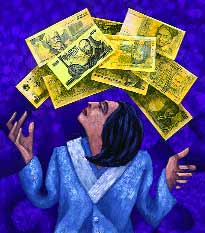
Earlier, we presented a series of lessons on man-down draws. Today, we'll extend that series by showing two examples on winning a won game and one more on pulling off a man-down draw.
It's more than a little interesting and instructive to look at man-up positions that ought to be a win, but aren't all that easy to carry out. Here's the first one, credited to E. McMillan. Black is ahead in numbers, but has three single men who haven't moved very far, while White has one king and may soon have another.
WHITE
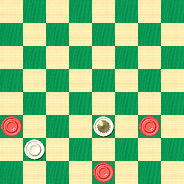
BLACK
Black to Play and Win
B:WK10,8:B12,9,2.
Now, let's look at a position put forth long ago by the legendary Joshua Sturges. Here we're to draw with a man down. Note that some key elements are in place: Black, though inferior in numbers, has two kings to White's one, and the White men are on the edge of the board.
WHITE
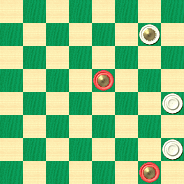
BLACK
Black to Play and Draw
B:WK25,13,5:BK18,K1.
In our final example, Black is ahead in the piece count but has one king against White's two, and White seems to have chances at obtaining Payne's Single Corner Draw.
C. ADAMSON
WHITE
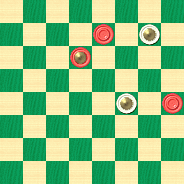
BLACK
Black to Play and Win
B:WK25,K14:B26,K23,13.
After you've worked through these problems, click on Read More for Ben Boland's detailed solutions, example games, and copious notes.![]()
A Checker Author, Too

Fred Reinfeld is a member of the United States Chess Hall of Fame, and quite deservedly so. As a champion player and prolific writer and teacher, his gift for turning complexity into comprehensibility has brought chess lore and learning to millions of players over the years.
What is less well known is that Mr. Reinfeld, who passed away at only age 54, wrote on many other subjects; he was a checker author, and, alas, has gotten little recognition for his single work, How to Win at Checkers (which has appeared in various other forms and titles but is essentially the same item). That's a shame, as this book, still in print in an inexpensive softcover edition, provides much worthy material for beginning to lower-intermediate players (see our Book Reviews, linked in the right-hand column). If you don't have this book, you really ought to get it.
The book does, however, have a couple of rough spots (rather few, as it turns out), and today we're inviting you to work through them and gain a little of recognition for yourself (even if only you will ever know). Let's start with the easy one first, which arises from the Denny opening.
Situation One
| 10-14 | 24-19 |
| 11-16 | 28-24 |
| 16-20 | 19-15 |
| 9-13 | 23-19 |
| 7-10 | 32-28 |
| 14-18 | 21-17 |
Here White should have played 26-23, which maintains a very slight advantage. But now watch Black take advantage of White's error:
| 10-14 | 17-10 |
| 13-17 | 22-13 |
| 18-23 | 27-18 |
| 20-27 | 31-24 |
| 8-11 | 15-8 |
| 6-31 |
BLACK
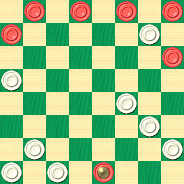
WHITE
White to Play, Black Wins
W:W8,13,19,24,25,28,29,30:B1,2,3,4,5,12,K31.
Mr. Reinfeld concludes at this point, "Black wins. He will win the man on 8, and he has a King." While it turns out that Black indeed does win, it may not be as obvious as Mr. Reinfeld implies, at least to the eyes of a non-expert player. In fact, a beginner might attempt the following sequence:
| 24-20 | 4-11 |
| 30-26 |
which swaps off the king and maintains material equality, or so it seems.
Your task in this position is twofold: (a) show why trading off the king in this manner loses; and (b) from Diagram 1, demonstrate the Black win. Neither of these assignments are all that hard.
Situation Two
Here's another Denny opening:
| 10-14 | 22-18 |
| 11-16 | 25-22 |
| 16-20 | 24-19 |
| 8-11 | 19-15 |
| 4-8 | 22-17 |
| 12-16 | 17-10 |
| 7-14 | 29-25 |
| 3-7 |
BLACK
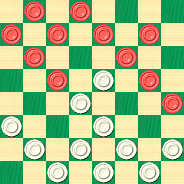
WHITE
White to Play and Win
W:W15,18,21,23,25,26,27,28,30,31,32:B1,2,5,6,7,8,9,11,14,16,20.
| ... | 15-10 |
| 6-29 | 30-25 |
| 29-22 | 26-3 |
| 8-12 | 3-8 |
WHITE
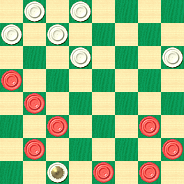
BLACK
Black to Play and Draw
B:W32,31,28,27,23,21,K3:B20,16,11,9,8,5,2,1.
and now Mr. Reinfeld tells us, "White wins. His King will prove too strong for the Black men."
But the problem with this is that White, despite the spectacular fireworks, is a man down! So we now come to a rather difficult threefold assignment: (a) show that the position in Diagram 2B is a draw; (b) show that, after 3-7 above, Diagram 2A, White actually does win, but not with 15-10; and (c) in the runup to Diagram 2A , find Black's losing move and correct it.
And if you really want some respect, show that 2-7 instead of 3-7 still loses (we haven't included the solution; you're on your own)[1].
We've probably outlined several days of work, but when you're ready, click on Read More for some potential solutions.![]()
Fred Reinfeld's photo is used with the kind permission of his son, cellist and bow maker Don Reinfeld.
[1] 12-1/2 years after publication we revisited this analysis with the latest KingsRow computer engine, and found the position is indeed a draw after 2-7! Congratulations Mr. Reinfeld, it's to you that our respect goes.
[Read More]Willard Who?

Have you ever heard of problemist Willard E. Davis? Maybe not (and that's not him in the photo, either), but we'd like to show you one of his little offerings, composed over 80 years ago and still instructive today.
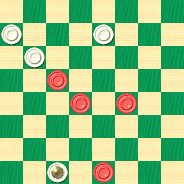
BLACK
Black to Play and Draw
B:W28,26,24,K3:B19,15,14,2.
Black is certainly in a bit of a predicament, but the draw is there, and in fact we'd have to say this problem is a little easier than many. Can you find the solution, or will Willard get the best of you? Click on Read More to check your answer.![]()
What's Your Speed?
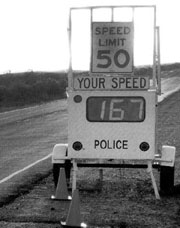
Here's a double-barrel offering which combines a more-or-less "regular" problem with a quickie. Let's start here, in a position that looks very bad for the White team.
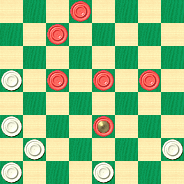
WHITE
White to Play
W:W13,21,25,28,29,31:B2,6,14,15,16,K23.
You can check this out any way you like and see that it's a White loss; the best try seems to be 25-22 after which play would probably go something like this:
25-22 14-18 22-17 18-22 17-14 15-19 14-9 16-20 9-5 23-18 21-17 18-15 Black Wins.
But instead suppose White tries 28-24, giving this position:
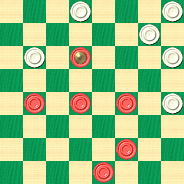
BLACK
Black to Play and Win
B:W31,29,25,24,21,13:BK23,16,15,14,6,2.
Can you find a Black win here? There is a move that looks like an instant win, yet, surprisingly enough, allows for a quick White draw. But that's the subject of the 'speed' portion of our problem.
First find the Black win above (there are two possible answers), and then click below to launch the speed problem and start our timer, which monitors your speed as carefully as the radar device depicted above. Click on Read More for the answers and a little about the problem's background.
We won't impose a time limit for this one; after all, we don't want you to get a speeding ticket.
Speed Problem (fairly easy)![]()
Introducing Priscilla K. Snelson
Marvin J. Mavin, Captain of the Detroit Doublejumpers of the National Checker League, looked somewhat uncomfortable and perhaps more than a bit out of place.
The occasion was the Annual Tasting Gala of the Greater Detroit Fine Champagne Association, and Marvin had been brought to this event, despite his protests, by his girlfriend, Priscilla K. Snelson. Priscilla, who to her disliking was affectionately called "P.K." by Marvin, is Executive Vice President for Marketing at the Mighty Motor Company of Detroit. A graduate of University of Manchester and the Sloan School of Economics, she is a cultured and sophisticated businesswoman, and, well, we must admit it, rather a contrast to her boyfriend Marvin.


Marvin and Priscilla

The waiter glared and Priscilla hissed, "Marvin, please!" Marvin, touching her arm, whined, "Aw, P.K., you know I don't dig this Frenchy stuff.... what's wrong with a nice cold bottle a Belcher's?"
Priscilla, not deigning to answer, quickly steered Marvin away from the group and in another direction. "How can you be like that," she said in a tight and clearly displeased voice. "And don't call me P.K.!"
A small, stocky man waved from the other side of the room. Priscilla brightened and waved back. "Come, Marvin," she said, "I want you to meet Dmitri. Perhaps you can try to get along with my friends?"
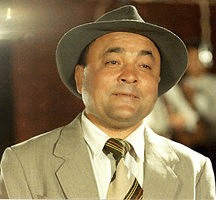
Dmitri
"Checker boy?" Marvin exclaimed, "I happen to be a top ranked professional checker..."
"Da, da," interrupted Dmitri, "checkers boy! I am myself very high rank master of shashski... shashki master can crush any silly checkers boy." (Editor's note: shashki is Russian draughts.)
Marvin was getting more than a bit red. "Marvin...." Priscilla cautioned, but Marvin had already erupted. "Listen here, Comrade Commie, hows about you put a few rubles behind your big mouth and play a little friendly game, hah!"
"How dare you insult my friend..." Priscilla began, but Dmitri interrupted, "Oh, checkers boy becoming angry checkers boy," he oozed, "da,da, we play game for one thousand dollars US, you think?"
"A thou...that's a lotta beer," muttered Marvin under his breath, and then said aloud, "Yer on, Pinko."
"MARVIN, ENOUGH!" shouted Priscilla, but he was already on the way out to the parking garage to fetch his checker set from Priscilla's Mercedes. "Be right back P.K.... er... honey," he called over his shoulder.
Fifteen minutes later Marvin and Dmitri were seated on opposite sides of the checker board, with a very displeased Priscilla standing at the side, and a crowd of onlookers, bearing champagne glasses, gathered around the table.
The play was intense, and somewhere along the line, Marvin went down a piece, with the game finally arriving at the following position.
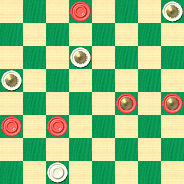
WHITE (Marvin)
White to Play
W:WK4,K10,K13,30:B2,K19,K20,21,22.
Dmitri was clearly grinning, looking about at the crowd for signs of approval. "You see it, da? American checkers boy is down one piece. Dmitri will be winning 1,000 dollars US very soon. Will buy fine Russian vodka for all good champagne people cheering for Dmitri!"
At this, the crowd was smiling, relishing the thought of a vodka chaser to their liberally imbibed glasses of champagne. But Marvin, in contrast, looked more than a bit worried; he was fidgeting in his chair and repeating over and over, "If only I had a beer...."
Can Marvin pull this one out, as he has done in the past with so many other tough positions? Will Priscilla remain angry or will they patch things up? Will Marvin ever get his beer?
Learn the answers to these questions when we conclude the story in a month or so, but meanwhile, see what you can do with the challenging position shown above.
Editor's Note: We believe this to be quite a difficult position to work out, but we invite you to match wits with our hero Marvin and see how you do.![]()
The Masked Man Rides Again
We thought we were done with our Masked Man series, but we came across something just too good to pass up. Here's a photo of the subject of this article:

Now for the situation:
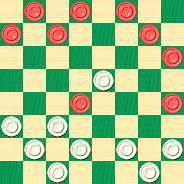
WHITE
White to Play and Win
W:W15,21,22,25,26,27,28,30,32:B1,2,3,5,6,8,12,18,20.
Our Hero's opponent made an egregious blunder a couple of moves back. The position in the diagram arose after a couple of forced trades. In the actual match, said Hero missed the win. Can you succeed where he did not? And while you're at it, can you name the man in the photo? How about his opponent? How about the year and location of the match, and the results?
We're asking a lot, so we won't tease you any further. After you've given this your best shot, click on Read More to see the solution, an animation of the complete game, and the answers to all of our questions.![]()
A Little More Practical, Well, Maybe

Our stroke problems, we like to think, have been challenging, elegant, and charming (if we do say so ourselves), but they have had a certain artificiality in their makeup. So, for a bit of a change, we'd like to present you with one that may be of a somewhat more practical nature. At least, maybe. Or maybe not?
Here's the problem:
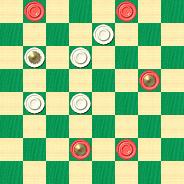
WHITE
White to Play and Win
W:W7,K9,10,17,18:B1,3,K16,K26,27.
The eminently practical solution can, as always, be viewed by clicking on Read More.![]()
Oldies But Goodies
Having completed republication of the introductory section to Willie Ryan's classic Tricks Traps & Shots of the Checkerboard, this month we swing into the main part of the book: a compendium of situations both famous and not-so-famous. Today, we present two classics which you've most probably seen before. If so, you'll have no trouble solving them.... right?
Here's Willie in his own words.
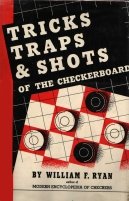
Don Canalejas' Cannonball
Almost 300 years ago, a Spanish mathematician, Don Canalejas, pointed out the most famous of all booby traps, a five-move demoralizer. This is the first pitfall the student should learn to avoid. Set the pieces up for play. Then move 11-16, 23-18, 16-20, 24-19, 8-11---A, forming the position on the adjoining diagram.
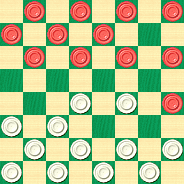
WHITE
White to Play and Win
W:W18,19,21,22,25,26,27,28,29,30,31,32:B1,2,3,4,5,6,7,9,10,11,12,20.
The Fool's Trap
Another premature opening procedure, which frequently embarrasses the beginner before he gets half started, is the Fool's Trap, another five-move paralyzer second in importance to Canalejas' Stroke. Set the pieces up for play. Then move 10-15, 23-19, 6-10, 22-17, 11-16---A, and we arrive at the situation shown in the diagram.
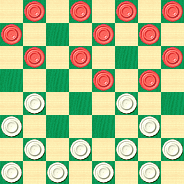
WHITE
White to Play and Win
W:W17,19,21,24,25,26,27,28,29,30,31,32:B1,2,3,4,5,7,8,9,10,12,15,16.
In each problem, find the winning move for White, and correct Black's play at A. Click on Read More to check your solutions.![]()
Checker School: Coming From Behind, Part 3

The final installment of our three-part lesson on man-down draws is a triplet. In the first two settings we'll see more ways to come from behind, while in the third setting, alas, we won't be able to pull it off.... but from this we'll learn what to try to avoid.
Ever been a man down in an endgame? Not you, right? As we've said in the other lessons in this series, it happens to everyone. Saving the draw, when possible, is an important skill to master. If you're a student, study this lesson carefully. If you're an advanced player, a review of what we take to be "obvious" can never hurt!
Let's start out with this position:
WHITE
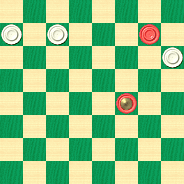
BLACK
Black to Play and Draw
Next, the famous Payne's Double Corner Draw, which should be learned by everyone who ever touches a checkerboard:
WHITE
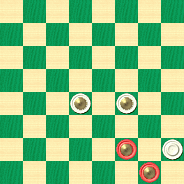
BLACK
Black to Play and Draw
And finally, a lost opportunity, to be contrasted with the very similar-looking Payne's Double Corner Draw:
WHITE
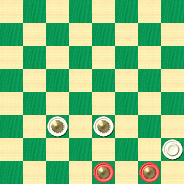
BLACK
Either to Play, White Wins
Take your time working these out, and then click on Read More for solutions, a sample game, supplementary problems, additional examples, and a host of detailed explanatory notes.![]()
The Simple Life

This past holiday season was filled with the usual hustle and bustle, and often stress triumphed over enjoyment. Many of us are a bit relieved, in fact, to return to the simpler, more ordinary days of the year.
Here's a Tom Wiswell problem, then, that seems to promise us the joy of simplicity.
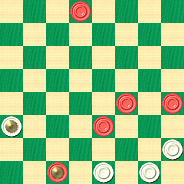
WHITE
White to Play and Draw
W:WK21,28,31,32:B2,19,20,23,K30.
White is a man down but regaining it is child's play. Has the simple life arrived, and have we solved a Wiswell problem in mere seconds?
Alas, life is not easy, and neither is this problem. Can you, without too much stress, see through to the solution, and bask in contented post-holiday enjoyment?
Don't fret. You can always click on Read More to check your answers.![]()
The Checker Maven is produced at editorial offices in Honolulu, Hawai`i, as a completely non-commercial public service from which no profit is obtained or sought. Original material is Copyright © 2004-2025 Avi Gobbler Publishing. Other material is the property of the respective owners. Information presented on this site is offered as-is, at no cost, and bears no express or implied warranty as to accuracy or usability. You agree that you use such information entirely at your own risk. No liabilities of any kind under any legal theory whatsoever are accepted. The Checker Maven is dedicated to the memory of Mr. Bob Newell, Sr.

